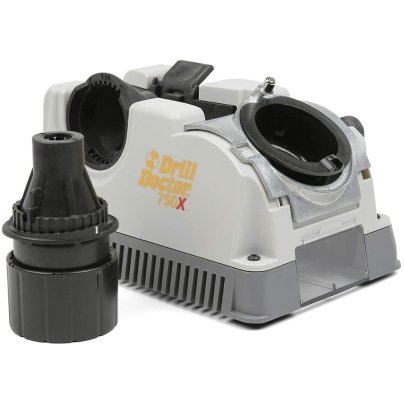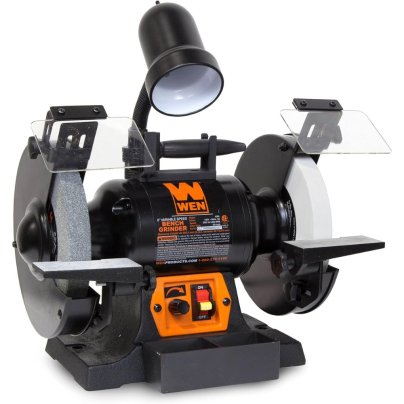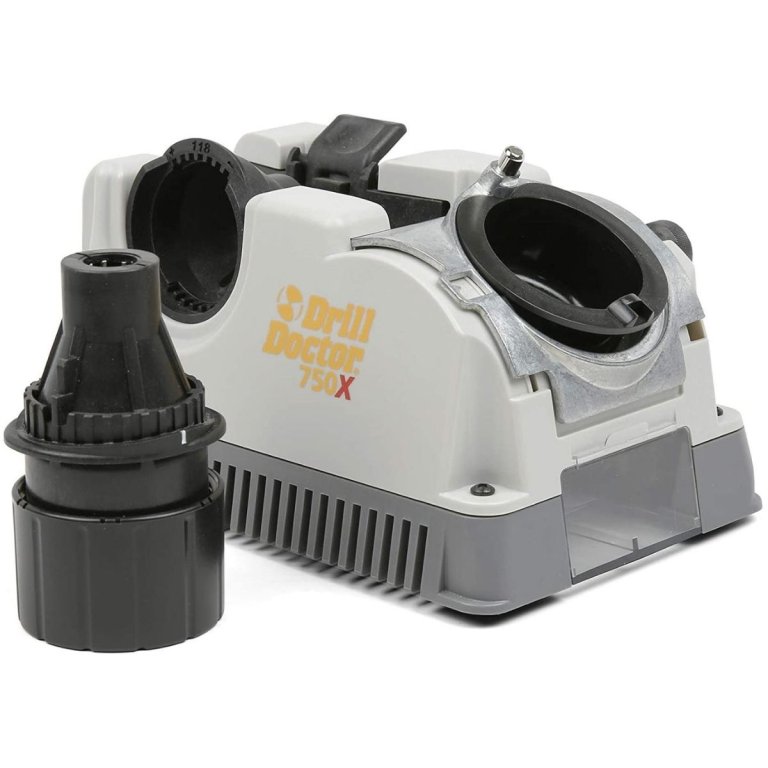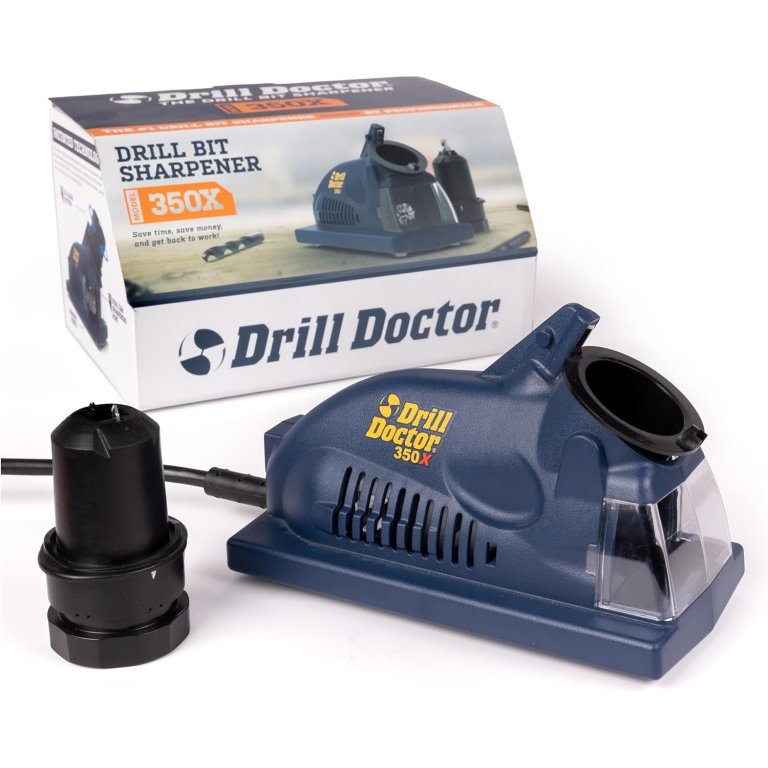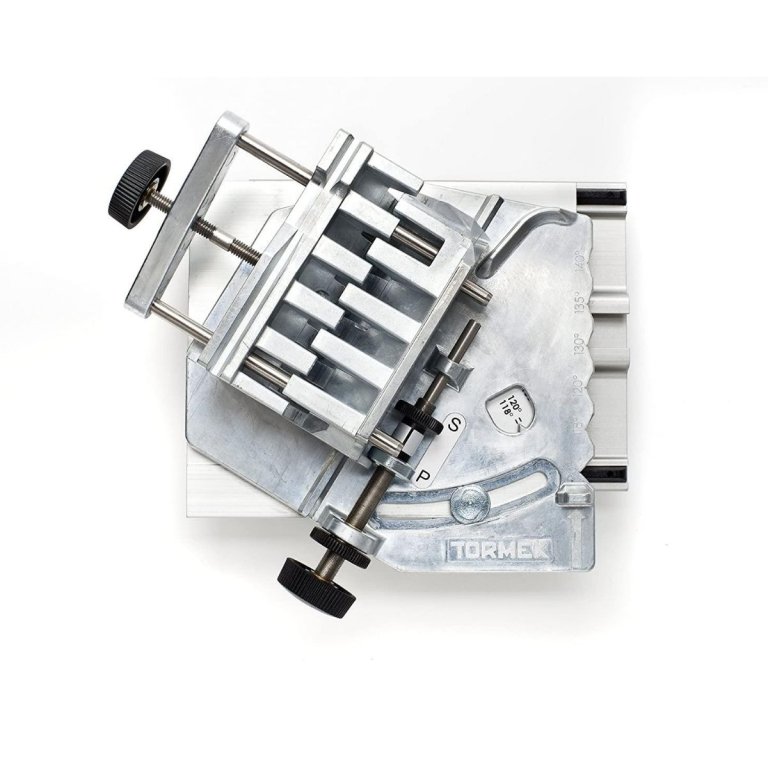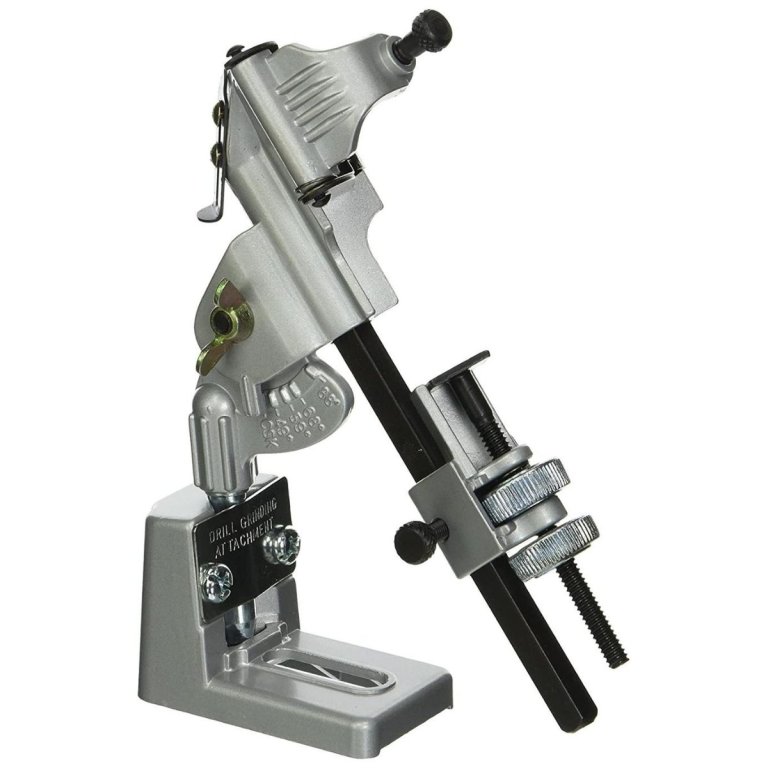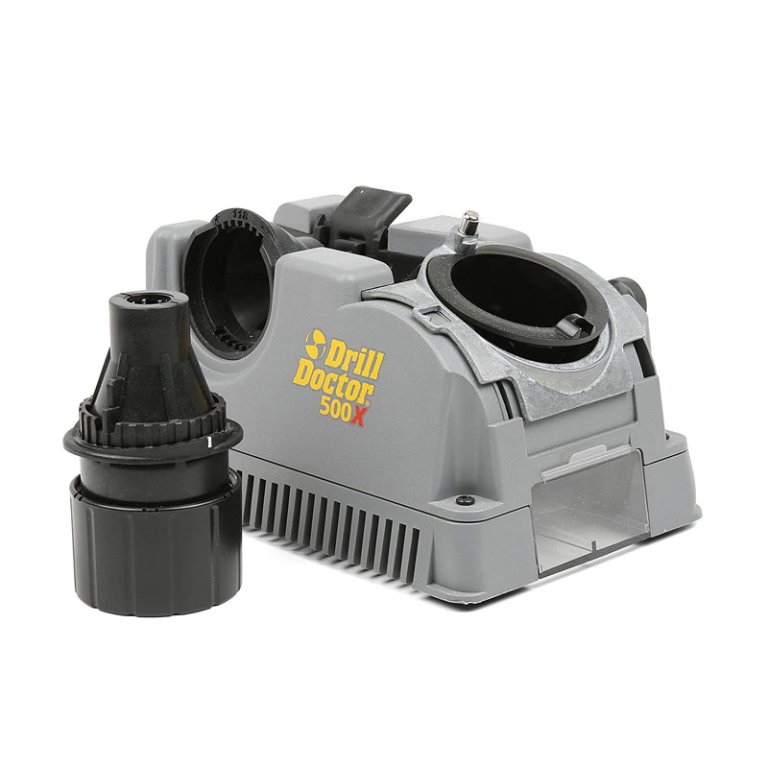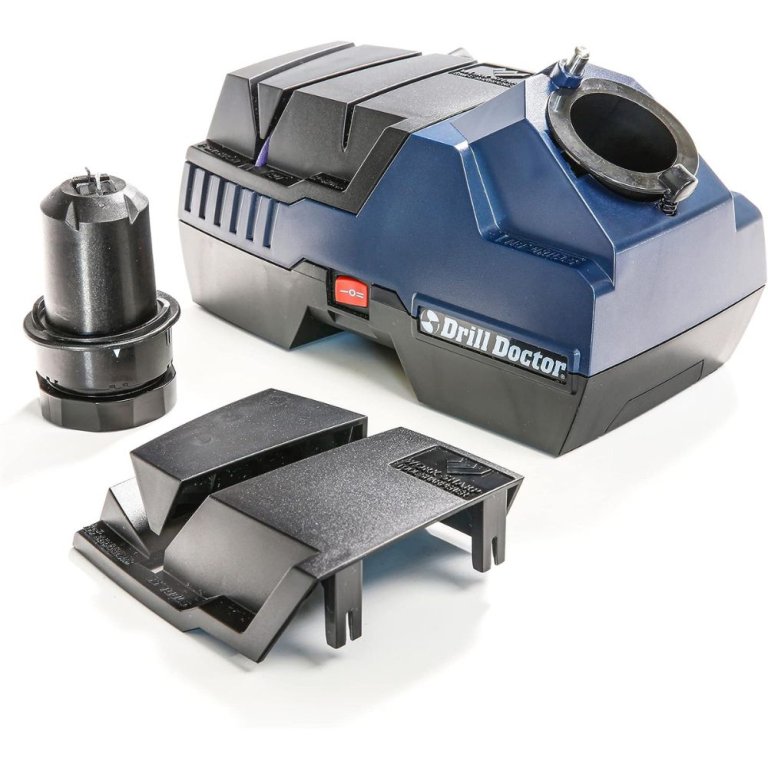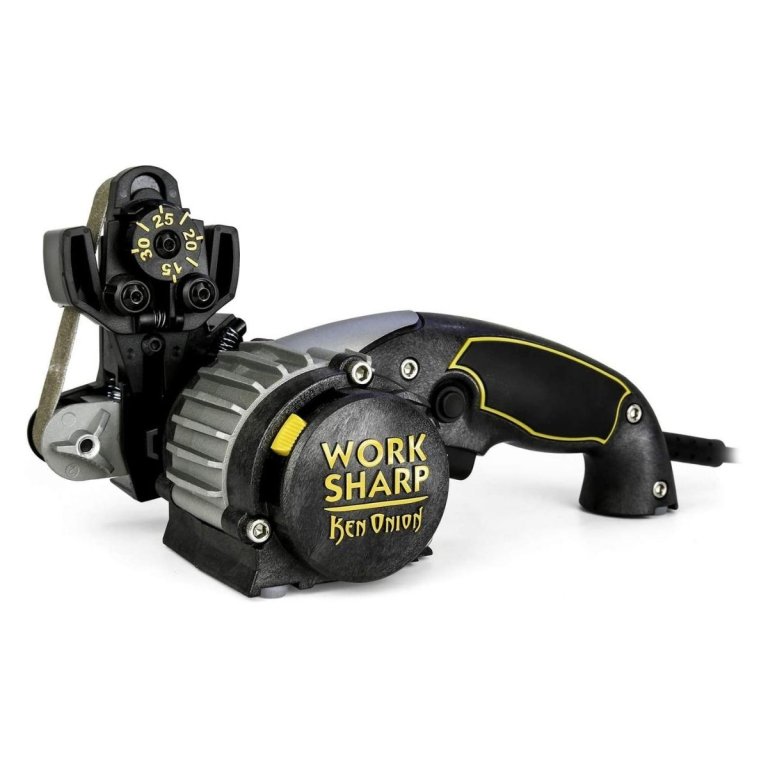
We may earn revenue from the products available on this page and participate in affiliate programs. Learn More ›
If your drill bits no longer work like they used to, a drill bit sharpener can bring back their edge. Whether you work with wood, metal, or plastic, sharp tools work faster and more precisely than dull ones, making the job easier and saving money in the long run. With this in mind, we spent two days testing four popular drill bit sharpeners. We learned a lot by sharpening 100 dull drill bits, including carbon steel, high-speed steel, titanium-coated, and cobalt options. Some of the sharpeners were less expensive and others were easier to use, but they all put a sharp edge on our worn drill bits.
Our favorite model was the Drill Doctor 750X because it was easy to use on different drill bit types and sizes, worked fast, and sharpened many of our bits to better-than-new condition. But if you prefer the multi-purpose nature of a bench grinder or a more compact or lower-cost option, we also tested several other models that might fit the bill. In this review, we share our observations from testing and offer shopping considerations to help you find the best drill bit sharpeners for your workshop.
- BEST OVERALL: Drill Doctor 750X Drill Bit Sharpener
↓Jump to Review - BEST BANG FOR THE BUCK: Drill Doctor DD350X Drill Bit Sharpener
↓Jump to Review - BEST MULTI-PURPOSE: Wen BG4280 Drill Bit Sharpener
↓Jump to Review - BEST PROFESSIONAL: Tormek DBS-22 Drill Bit Sharpener
↓Jump to Review - BEST JIG: General Tools 825 Drill Grinding Attachment
↓Jump to Review - BEST FOR SMALL BITS: Drill Doctor DD500X Drill Bit Sharpener
↓Jump to Review - BEST COMPACT: Drill Doctor X2 Drill Bit Sharpener
↓Jump to Review - MOST VERSATILE: Work Sharp Ken Onion MK2 Knife & Tool Drill Bit Sharpener
↓Jump to Review
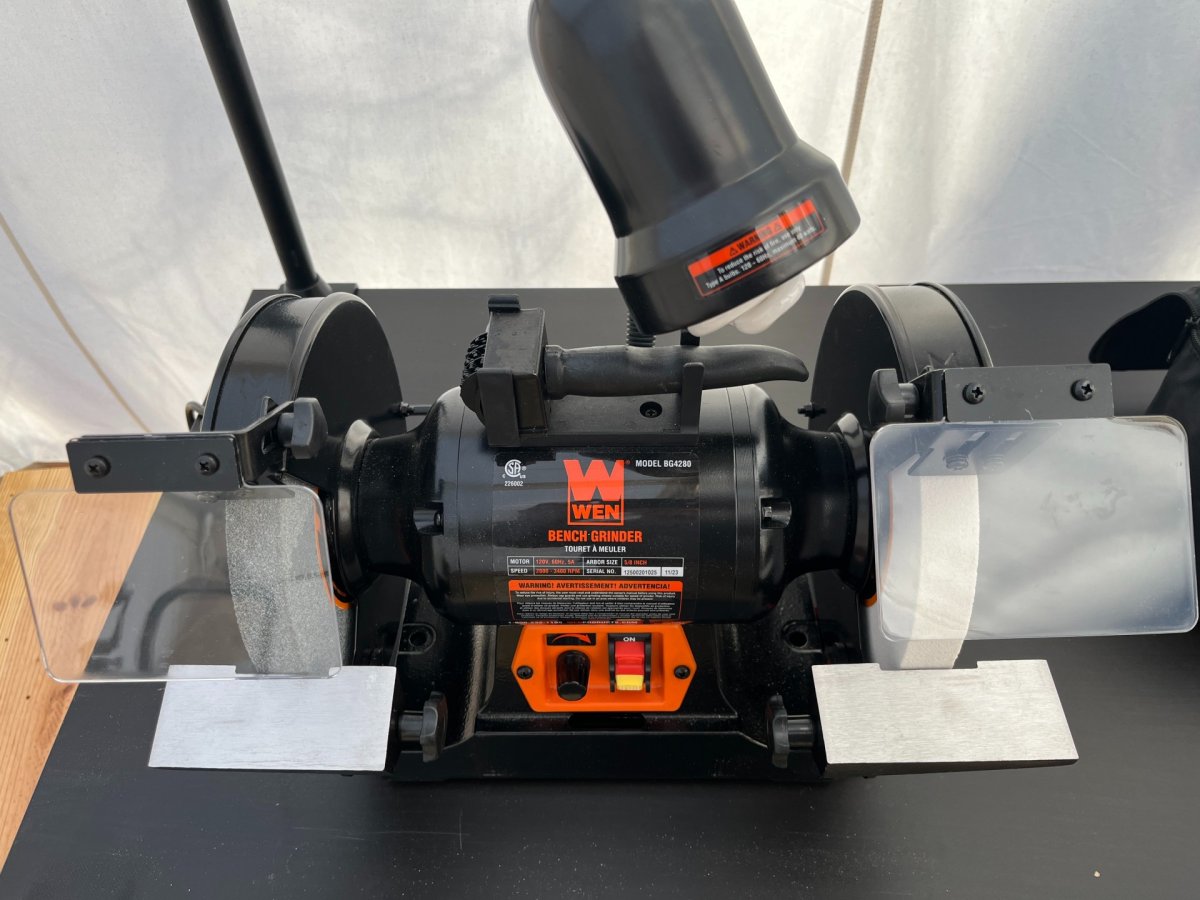
Drill Bit Sharpeners Comparison Chart
| Type | Bit sizes | Tip angles | Split tips? | |
| Drill Doctor 750X | Sharpener | 3/32-inch to ¾-inch | 115 degrees to 140 degrees | Yes |
| Drill Doctor DD350X | Sharpener | 3/32-inch to ½-inch | 118 degrees | No |
| Wen BG4280 | Bench grinder | All | Any | No |
| Tormek DBS-22 | Grinder accessory | ⅛-inch to ⅞-inch | Any | No |
| General Tools 825 | Grinder accessory | ⅛-inch to ¾-inch | 176, 136, 118, 98, and 82 degrees | No |
| Drill Doctor DD500X | Sharpener | 3/32-inch to ½-inch | 118 degrees or 135 degrees | Yes |
| Drill Doctor X2 | Sharpener | 3/32-inch to ½-inch | 118 degrees | No |
| Work Sharp Ken Onion Knife & Tool Drill Bit Sharpener | Sharpener | All | Any | No |
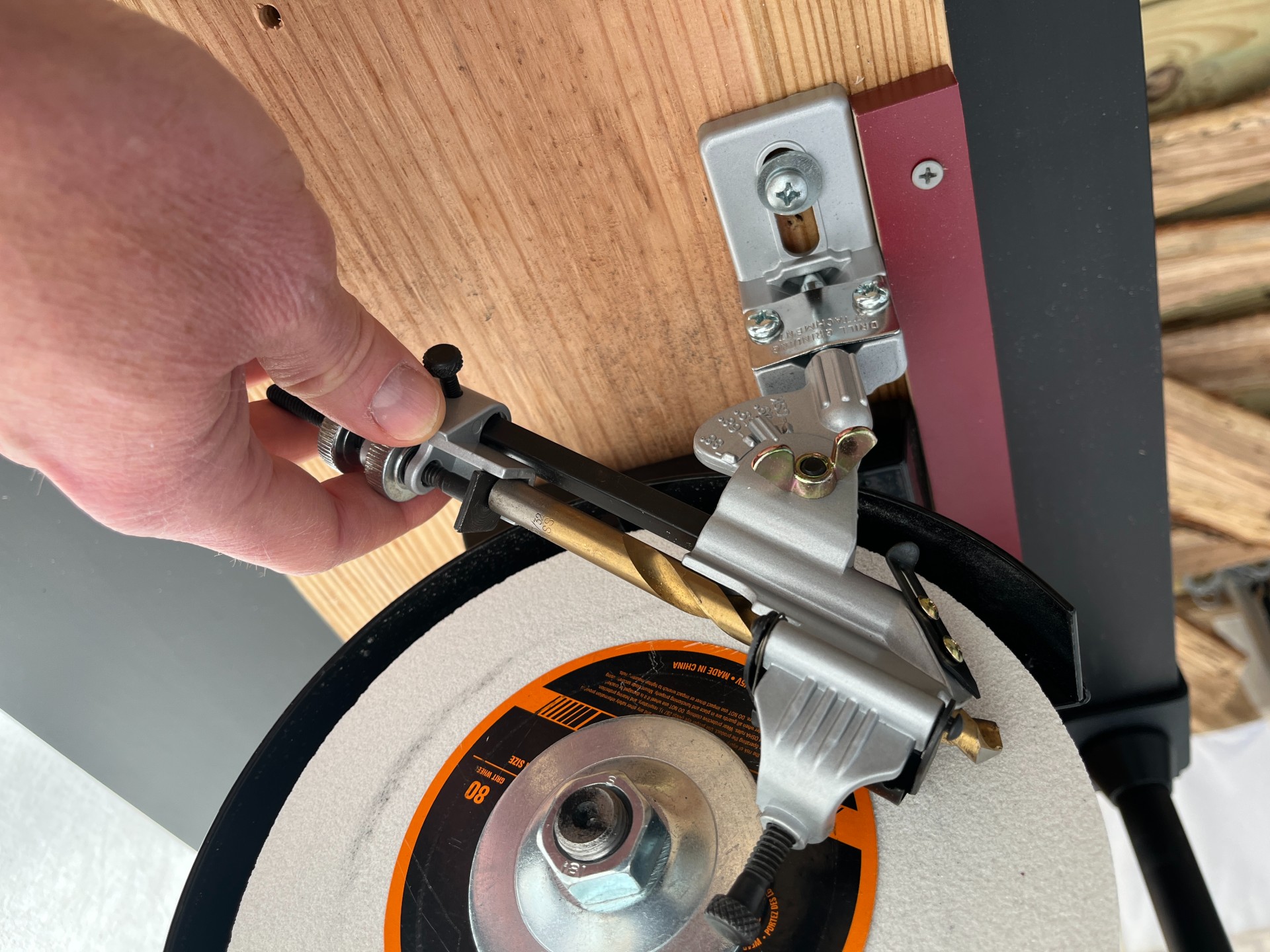
Our Top Picks
In the reviews ahead, you will see that all of the sharpeners we tested are capable of rejuvenating dull drill bits. They are easy to use, accurate, and extend the working life of the best drill bits in your collection.
Best Overall
Drill Doctor 750X Drill Bit Sharpener
What We Like
- Compatible with all drill bit materials
- Adjustable sharpening angle
- Sharpens bits up to ¾-inch in diameter
- Renews split points
What We Don’t Like
- Not compatible with quick-connect shanks
- Single-purpose tool
Specs
- Type Bit sharpener
- Tip angles 115 to 140 degrees
- Bit sizes 3/32 to ¾ inch
Our Ratings: Ease of Use 5/5; Performance 5/5; Build Quality 5/5; Value 5/5
If you’re considering an electric drill bit sharpener that allows you to get the most out of your old drill bits, the Drill Doctor 750X deserves a close look. It works with bit sizes from 3/32 inch up to ¾ inch, and it has a quick calibration system to accommodate any tip angle from 115 to 140 degrees. The diamond grit sharpening wheel works on all types of bits, including tough cobalt drill bits and carbide tips. It’s also capable of creating or renewing split points. Simply put, this was the most widely adaptable system we tested outside of freehand sharpening.
We used the DD750X sharpener on black oxide, titanium nitride, cobalt, and carbide-tipped drill bits and it worked perfectly on every material, although it did grind away the coating on cheaper bits. It even put a new edge on a bit that had been broken in half. The only twist bits we could not sharpen with this machine were those with quick-connect hex shanks because they would not fit securely in the chuck.
The sharpening process was fast and easy from one bit to the next, with no need to recalibrate the machine in between. Instead, a quick chuck setup process ensured that the bit would be sharpened at the desired angle. After sharpening the cutting edges, we could use the side port to renew split points, or even convert conventional twist bits to twist points in less than 5 seconds. Total sharpening time for each bit averaged less than 2 minutes.
What our tester says: “I usually prefer multipurpose shop tools, but drill bits can be tricky. A simple calibration system and near perfect results every time made the DD750X my favorite of the group.” —Mark Wolfe, writer and product tester
Get the Drill Doctor 750X drill bit sharpener at Amazon or Lowe’s.
Best Bang For The Buck
Drill Doctor DD350X Drill Bit Sharpener
What We Like
- Easy to set up and operate
- Works with standard twist bits
- Diamond wheel sharpens quickly
- Budget-friendly price
What We Don’t Like
- Limited to 118-degree tip angle
- Does not renew split points
Specs
- Type Bit sharpener
- Tip angles 118 degrees
- Bit sizes 3/32 to ½ inch
Our Ratings: Ease of Use 5/5; Performance 4.7/5; Build Quality 5/5; Value 5/5
Sharpening drill bits is all about saving money, and the Drill Doctor DD350X drill bit sharpening tool will do that time and time again. This low-priced sharpener puts a fresh 118-degree grind on any old, dull drill bit. The diamond sharpening wheel works with standard 3/32-inch to ½-inch twist drill bits made of any material.
Drill Doctor made the DD350X more compact so it can sit on a shelf without getting in the way, but it does not include all of the features found on more expensive Drill Doctor models. It only sharpens to a single tip angle and it is not equipped to process split points. Since split points are more common among 135-degree drill bits, that may be expected. As with the other Drill Doctors, the DD350X does not accommodate hex shank drill bits.
In keeping with our testing model, we used the DD350X to sharpen all types of drill bits, with the full range of tip angles. It converted all kinds of worn bits into sharp 118-degree standard twist bits. If you have dull 135-degree bits, this sharpener will turn them into sharp 118-degree bits. If your dull bits have split points, this sharpener will eventually “erase” the split. This could be the ideal choice for maintaining woodworking bits or bringing flea market finds up to a workable standard, but not for bits that require a shallower angle for drilling hardened steel and other tough materials.
Get the Drill Doctor DD350X drill bit sharpener at Amazon or Northern Tool + Equipment.
Best Multi-Purpose
Wen BG4280 Drill Bit Sharpener
What We Like
- Includes 80-grit and 36-grit wheels
- Built-in work light boosts visibility
- Sharpening template with 118-degree angle guide
- Quick and easy way to sharpen larger bits
- Handles numerous metal grinding tasks
What We Don’t Like
- Wheels may require manual balancing
- Less convenient for sharpening small bits
Specs
- Type Bench grinder
- Tip angles All
- Bit sizes All
Our Ratings: Ease of Use 4.7/5; Performance 4.5/5; Build Quality 5/5; Value 5/5
Bench grinders find plenty of use around the shop, including to sharpen drill bits. Versatile and affordable, this model from Wen features a 5-amp variable-speed motor that operates between 2,000 and 3,450 revolutions per minute for sharpening virtually any drill bit size. It also has a built-in work light, a quenching tray, dual spark guards, a large on/off switch, and medium (80-grit) and coarse (36-grit) 8-inch grinding wheels, making it ideal for sharpening drill bits by hand, deburring and shaping parts, and other metal grinding tasks.
We used the Wen bench grinder to sharpen drill bits with and without the included drill bit sharpening guide. The included sharpening guide, which threads in place over the tool rest, has a shallow groove to help hold bits at a 118-degree angle for sharpening. We found that by using a protractor and straight edge, we could simply scribe a temporary guide line directly on the tool rest at whatever angle we needed. Sharpening bits freehand requires a moving grind technique that is not difficult to learn, and our results were quite good. However, with bits smaller than ¼ inch, precision and control became increasingly difficult as the bit size decreased.
What our tester says: “Sharpening drill bits on a bench grinder requires a sharp eye and steady hand, but it is a learnable skill. The 118-degree sharpening guide that came with the Wen bench grinder makes it easier to master the technique.” —Mark Wolfe, writer and product tester
Get the Wen drill bit sharpener at Amazon, Lowe’s, or The Home Depot.
Best Professional
Tormek DBS-22 Drill Bit Sharpener
What We Like
- Professional sharpening system
- Grinds self-centering four-faceted edges
- Repairs broken drill bits
- Improves wear life and precision of brand new twist bits
What We Don’t Like
- More expensive than most other options
- Requires an expensive bench grinder
Specs
- Type Bench grinder attachment
- Tip angles All
- Bit sizes ⅛ inch to ⅞ inch
Our Ratings: Ease of Use 4.3/5; Performance 4.5/5; Build Quality 5/5; Value 4.3/5
Those who require absolute precision, work efficiency, and maximum drill bit working life may want to check out the Tormek DBS-22. This professional drill bit sharpener is designed to create precise four-faceted drill bit tips at angles from 90 degrees to 150 degrees. The result is a bit that’s precise, smooth-cutting, and lasts up to four times longer than conventional twist bits. The DBS-22 sharpening jig works with drill bits from ⅛ inch up to ⅞ inch and accommodates any drill bit material, but it must be paired with a low-RPM wet bench grinder. Expect sharpening to take longer compared to other methods.
For the premium price—twice that of our top pick—this industrial drill bit sharpener is probably best for professionals or serious hobbyists who will use it often enough to see a return on the investment. The jig provides outstanding support to eliminate movement as the tip engages the slow-moving wheel. Re-profiling a mid-size drill bit to the four-facet profile takes 10 to 15 minutes. The end result is a super-sharp bit that retains its edge surprisingly well. For badly damaged bits, we recommend removing the damage with a conventional bench grinder or bit sharpener first before re-profiling with the Tormek.
Get the Tormek drill bit sharpener at Amazon or Walmart.
Best Jig
General Tools 825 Drill Grinding Attachment
What We Like
- Superior results to freehand sharpening
- Value priced for good accuracy
- Adjustable to grind different tip angles
- Works with a wide range of bit sizes
What We Don’t Like
- Less precise than our top pick
- Instructions might not be adequate for newcomers
Specs
- Type Bench grinder jig
- Tip angles 176, 136, 118, 98, and 82 degrees
- Bit sizes ⅛ inch to ¾ inch
Our Ratings: Ease of Use 4.3/5; Performance 4.5/5; Build Quality 5/5; Value 4.7/5
For folks who already have a bench grinder, the General Tools 825 drill bit sharpening jig is an affordable way to resharpen a pile of dull drill bits. The jig bolts to the worktop and uses the side of a grinding wheel to create sharp edges on old drill bits. This jig works with bits between ⅛ inch and ¾ inch and adjusts for numerous drill point angles. The bracket that retains the bit also has an adjustable backstop that allows users to slowly creep up on the perfect grinding depth for maximum accuracy. To create a perfectly centered point, simply roll the bit over between every pass.
Unlike freehand sharpening on the grinding wheel, the General Tools drill grinding attachment allowed us to use our bench grinder to sharpen smaller bits effectively. Setup was surprisingly easy despite the over-complicated instructions. However, with so many moving parts (an angle adjustment screw, a sliding backstop for the bit, a bit hold-down clamp, the pivot point, and the jig mount screw), there was a small degree of play in the system, so absolute perfection is not an option. But after a minute or two on the grinder with this jig, our bits turned out acceptably sharp for routine drilling.
Get the General Tools drill bit sharpener at Amazon or The Home Depot.
More Great Options
We did not test the following products, but the designs make sense and they come with excellent user ratings. If the models we tested don’t seem quite right for your workshop, one of these should be up to the job.
Best For Small Bits
Drill Doctor DD500X Drill Bit Sharpener
What We Like
- Sharpens fast with pro-quality results
- Creates and rejuvenates split-points
- Diamond wheel sharpens HSS, cobalt, and carbide
- Chuck upgrade available for sharpening bits up to ¾ inch
What We Don’t Like
- No mounting holes integrated to anchor it to a tabletop
Specs
- Type Bit sharpener
- Tip angles 118 to 135 degrees
- Bit sizes 3/32 inch to ½ inch
For smaller bits that are difficult to sharpen freehand, the DD500X from Drill Doctor makes it easy to get fast, efficient results. It offers two angle presets, 118 degrees for general drilling and 135 degrees for drilling hard materials, and features a diamond grinding wheel to grind high-speed steel, cobalt, or carbide bits efficiently. This model can also create or rejuvenate split points, which help to eliminate “walking,” especially with 135-degree points. The DD500X can sharpen drill bits between 3/32 inch and ½ inch, meaning it can handle most bits in a standard set.
If you’re not sure whether to go with this model or the pricier DD750X (our best overall pick), there are two main differences. This model is limited to the standard 118-degree and 135-degree angles, while our top pick offers the ability to customize the angle. Also, the chuck that comes with the DD500X only works with bits up to ½ inch, but can handle the upgrade to the same chuck used in our top pick, which sharpens bits up to ¾ inch.
Get the Drill Doctor DD500X drill bit sharpener at Amazon, Lowe’s, or The Home Depot.
Best Compact
Drill Doctor X2 Drill Bit Sharpener
What We Like
- Compact and lightweight construction
- Works with all drill bit materials
- Also sharpens scissors, knives, tools, axes, and more
- Dual-speed motor for optimum results
What We Don’t Like
- Limited to bits up to ½-inch
- Only sharpens to 118 degrees
Specs
- Type Bit sharpener
- Tip angles 118 degrees
- Bit sizes 3/32 inch to ½ inch
This sharpener can replace a cabinet full of sharpening stones, files, and grinding equipment as it keeps drill bits and most other household tools sharp. The versatile and compact Drill Doctor X2 sharpener weighs just 3 pounds and is small enough to fit inside a tool box or case. Made with an electric plug-in design, this Drill Doctor can sharpen drill bits, tools, knives, scissors, and more.
The small but mighty X2 comes with a ½-inch chuck for sharpening drill bits between 3/32 and ½ inch in the 118-degree drill bit sharpening port. It also includes two interchangeable sharpening guides, one for knives and the other for scissors and tools. The two-speed motor allows users to select the proper speed for the work at hand and avoid damaging cutting edges. For added convenience, this drill grinding machine also comes with a replacement abrasive disc and a user manual.
Get the Drill Doctor X2 drill bit sharpener at Amazon or Lowe’s.
Most Versatile
Work Sharp Ken Onion MK2 Knife & Tool Drill Bit Sharpener
What We Like
- Sharpens drill bits and most other bladed tools
- Variable speed control
- Includes five flexible abrasive belts
- Lightweight design for transport and storage
What We Don’t Like
- Requires some practice to nail the technique
- May be less effective on carbide tips
Specs
- Type Belt grinder
- Tip angles All
- Bit sizes All
The Work Sharp MK2 knife and tool sharpener was not specifically designed to sharpen drill bits, but it can do a reasonable job while offering other sharpening services in the shop. Work Sharp is best known for its ability to quickly sharpen knives, scissors, and other handheld tools. This package includes the blade grinding kit, a compact belt grinder attachment that can dress up the edge of a dull drill bit and get you back to work in a hurry. It comes with five belts of various coarseness levels, allowing users to put a serviceable edge on high-speed steel or cobalt twist drill bits.
Though it takes patience and precision to replicate the exact angle by hand, freehand sharpening is a common practice on larger drill bits. The MK2 includes adjustable sharpening guides for all knife and scissor sharpening needs, as well as chisels and other cutting tools, though carbide bits are probably too much for this tool. The lightweight unit is much smaller than a conventional belt grinder, making it perfect for professionals and DIYers to transport.
Get the Work Sharp drill bit sharpener at Amazon.
Jump to Our Top Picks
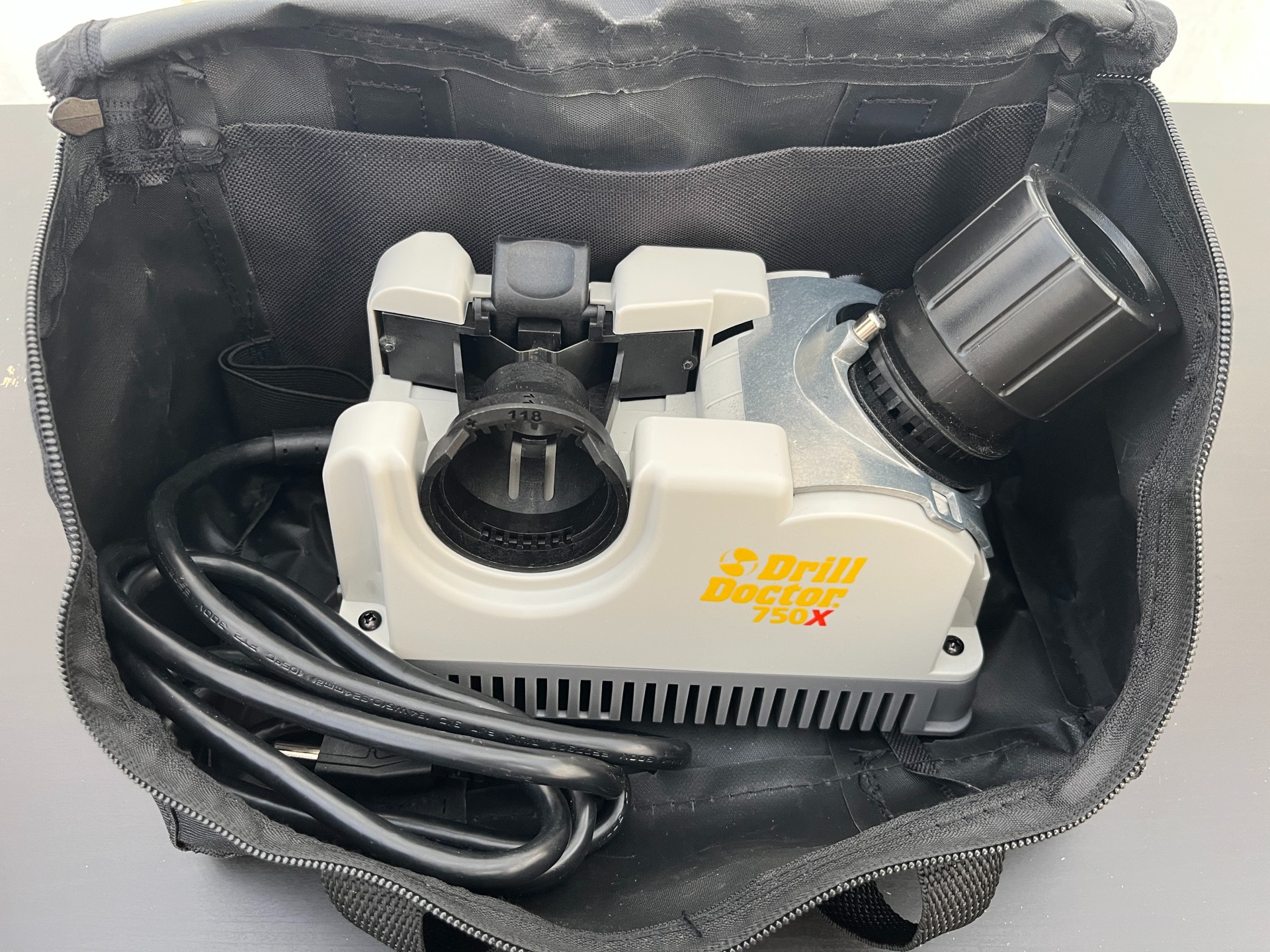
How We Chose and Tested the Best Drill Bit Sharpeners
| Products tested | 5 |
| Time spent testing | 2 days |
| Tests performed | 6 |
| Price range | $20 to $350 |
After researching popular tools and techniques that professionals and dedicated hobbyists use to sharpen drill bits, we compiled a list of sharpeners with the highest user ratings. All of the products we tested proved capable of renewing dull bits while catering to different user preferences, including precision, speed, size, affordability, and versatility. To test them, we collected 100 drill bits of varying sizes and types and then divided them into groups of 20 bits for each sharpener. We spent two days sharpening all of the bits and noting our observations with regard to ease of use, versatility, sharpening speed, bit sharpness, build quality, and value. Afterward, we scored each of the tested models on a rubric before awarding category titles.
| Ease of Use | Performance | Build Quality | Value | Rating Category | |
| Drill Doctor 750X | 5 | 5 | 5 | 5 | [Rating] |
| Drill Doctor DD350X | 5 | 4.7 | 5 | 5 | [Rating] |
| Wen BG4280 | 4.7 | 4.5 | 5 | 5 | [Rating] |
| Tormek DBS-22 | 4.3 | 4.5 | 5 | 4.3 | |
| General Tools 825 | 4.3 | 4.5 | 5 | 4.7 |
What to Consider When Choosing a Drill Bit Sharpener
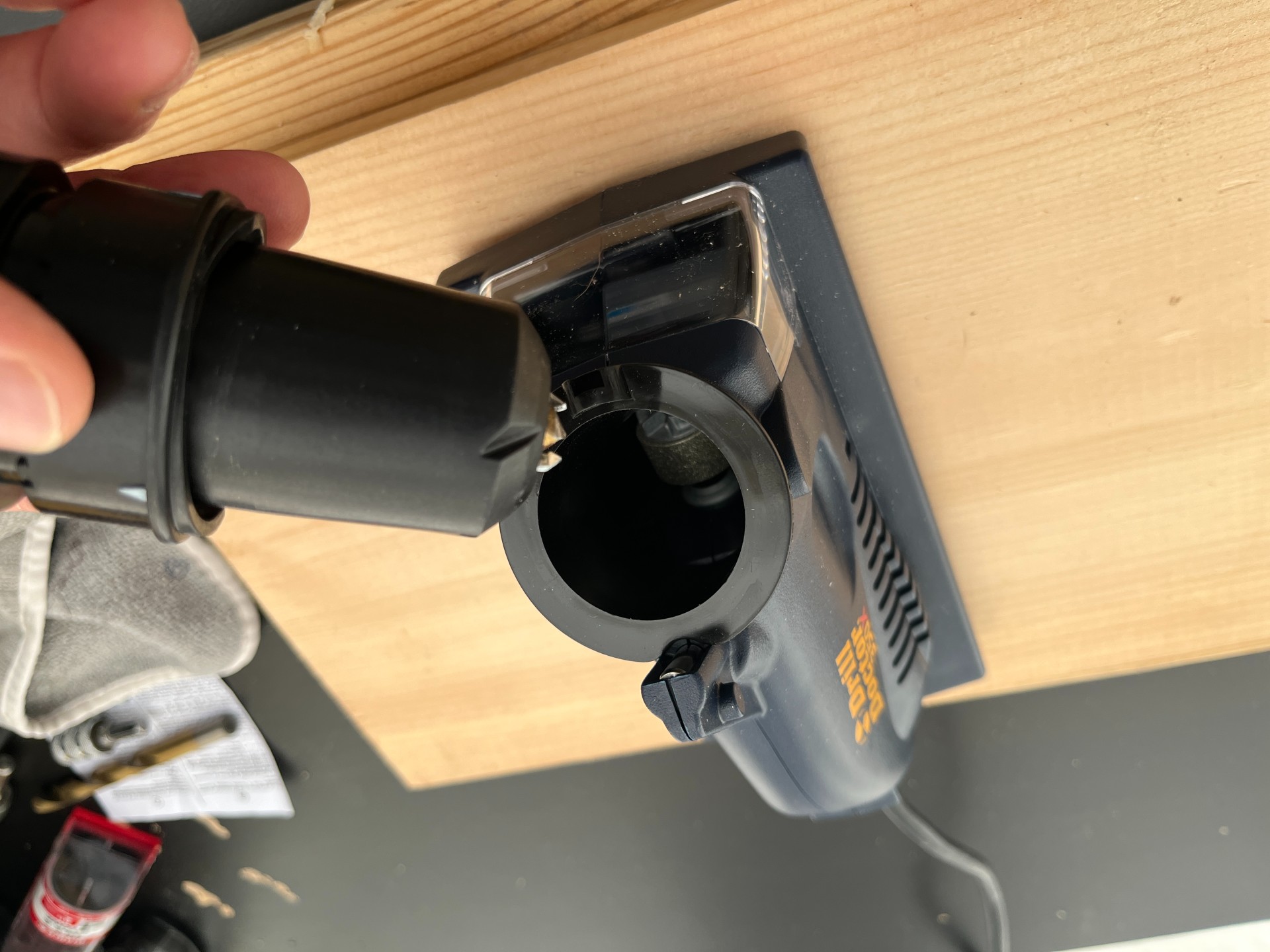
When looking for a drill bit sharpener, there are a few important factors to keep in mind. Not all models have the same capabilities or uses, so you need to be sure the drill bit type you choose will get the job done.
Size
Purchasing a drill bit sharpener that can handle all of the bits you commonly use should be a priority. While almost all sharpeners can handle small to mid-range bits, only certain models can handle the big stuff. Bits over 1/2 inch are expensive, so make sure to invest in a large drill bit sharpener that works with them.
Also ensure that the sharpener can handle the smaller bits that you use regularly. While these bits are rarely expensive (depending on the material), they can dull and lose their performance quickly. The best bit sharpeners will put a quick edge on a bit as small as 3/32 of an inch.
Material
Finding a drill bit sharpener that works with your drill bits of choice is important. For most homeowners, a standard drill bit sharpener will accommodate most of the bits in the workshop. These bits usually consist of steel or cobalt, and standard grinding wheels will sharpen them with ease.
High-end carbide drill bits won’t work with a standard grinding wheel. Carbide is extremely hard and requires a diamond wheel to sharpen correctly. To sharpen carbide bits, look for a sharpener that comes with diamond wheels or purchase a bench grinder jig to set up with a diamond grinder wheel.
Versatility
Various types of drill bits use differently angled cutting edges at their points. Bits reserved for wood have aggressive cutting edges to allow them to get through the material quickly. Drill bits for metal have flatter angles, allowing them to take off smaller bits at a time without overheating or chipping the bit.
While you can sharpen every drill bit to one consistent angle, certain styles of bits work best at specific angles. It’s better to have a sharpener with an adjustable angle. Standard angles are between 118 and 135 degrees, so look for a sharpener that allows you to switch between at least these two.
Power Source
There are two popular power sources for sharpening your drill bits: plug-in electric and drill-powered (which may be electric or battery).
- Plug-in electric-powered sharpeners are either benchtop sharpeners and adapters for bench grinders. The best benchtop sharpeners are quick and accurate, leaving little room for error. Grinder attachments can become misaligned with your grinder, so it’s essential to check for accuracy before you begin. A combination square will most likely do the trick. Once you check them, the grinder attachments are also quick and accurate.
- Drill-powered sharpeners are great in a pinch, or if you’re on a job site and need to sharpen a bit. Simply chuck the grinding stone’s spindle into the drill, and place your bit in the appropriate groove, and you’ll be back to cutting in no time. There is some room for mistakes here as they’re not incredibly accurate, but they do an excellent job if you’re in a pinch.
The Advantages of Owning a Drill Bit Sharpener
If you’re regularly working in your home shop or on a job site, having your own drill bit sharpener can save you quite a bit of money. Instead of throwing your old bits out, you can grind a new edge on the spot, or place them to the side and spend an hour grinding a whole set until they’re like new.
When paired with a good electric drill, sharp bits drill faster and more accurately. When the tip of a drill bit becomes dull, it won’t dig in exactly where you’d like it and will also drill crooked or elongated holes. A sharp bit will bore straight down and create a perfectly round hole in almost any material. Having your own drill bit sharpener will allow you to keep your bits in top condition.
Drill bit sharpeners can make using drill bits safer. If you’re drilling with a dull bit, you’ll have to use more force to make any progress. A smaller bit can easily snap under pressure, which sometimes sends pieces of drill bit flying. While you should always wear safety glasses, flying bits of metal are never safe. A sharpener will help ensure that you don’t need to put much power behind the bit.
- Owning a drill bit sharpener will save money on new bits.
- Sharpening bits makes them more accurate.
- Keeping bits sharp makes them safer.
Tips for Buying and Using a Drill Bit Sharpener
Drill bits aren’t cheap, but neither are sharpeners. If you’re not going through bits constantly, it may be useful to purchase an inexpensive, drill-powered sharpener to put an edge on bits. They do a decent job, and if you’re not drilling precision holes, they’ll grind a useful edge.
If you already own a bench grinder, an attachment may be the best route. They’re far less expensive than a benchtop model and can achieve the same angles. They take a little longer to set up, but you won’t sacrifice any quality once you do.
If ease of operation is important, consider purchasing an electric benchtop model. These are the most foolproof of the drill sharpener designs, and they will put a sharp edge on a drill bit in no time at all. A benchtop model is the most foolproof.
- Choose a drill-powered sharpener if you’re not going to sharpen bits often.
- A bench grinder attachment is a great option if you already own a grinder.
FAQs
Now that you do know a bit about the best drill bit sharpeners, you might have some more questions. Below are answers to the most frequently asked queries on the topic, which should also provide an idea of how to sharpen drill bits. If you don’t find the answer here, contact the sharpener’s manufacturer.
All bits are worth sharpening if you already have a sharpener. However, it’s not worth buying a sharpener to put an edge on a tiny, inexpensive drill bit.
Each sharpener is different, but generally, you, or the jig, hold the bit at a specific angle relative to a grinding wheel. The grinding wheel removes metal from the tip of the drill bit until the edge is sharp.
The two most common angles are 118 degrees and 135 degrees, though there are bits that use other angles.
You can, but they’ll never be quite as effective as they were when they were new. Titanium bits have a coating that the grinding wheel will remove when sharpening. That’s not to say the bits are no good; they just won’t have the hard coating that makes them so useful.
Sharpen drill bits every 10 to 20 holes, or whenever you notice that they are not drilling as smoothly as they should.
It’s a good idea to apply a light coat of oil after sharpening or using drill bits. This will keep them clean and ready for action the next time you need them, and will also protect them from surface rust.
The wear life of a drill bit depends on a wide range of factors, including the type of bit, the material being drilled, pressure, feed rate, and more. With proper usage and care, they should be able to drill hundreds of holes.
Drilling with care can improve the wear life of drill bits. Avoid over-tightening the bit in the chuck so that if the bit catches, it will spin inside the chuck instead of dulling the edge or breaking the bit. When drilling hard metals, use a slow drilling speed and high pressure to minimize heat buildup, and be sure to lubricate the bit and the hole while drilling.
Meet the Tester
Mark Wolfe is a writer, product tester, and serial DIYer who lives in an older home. When he isn’t writing, he spends his time upgrading, repairing, and replacing anything and everything in his home, yard, and garden. He tests and writes reviews about hand and power tools, lawn care and home repair products, and outdoor living goods.
Additional research provided by Tom Scalisi
